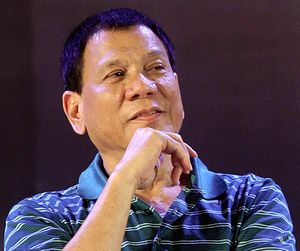Philippine President Rodrigo Duterte will visit Japan from October 25 to 27. While the full schedule of high-profile meetings between the leaders of the two U.S. allies would have been a significant regional event even in the dullest of times, Duterte’s remarks in Beijing last week injected an unexpected sense of urgency and uncertainty to his Japan visit.
In Beijing last Thursday, Duterte announced his intention to “separate” from the United States, and strengthen relations with China. Duterte was quoted as saying, “Both in military – not maybe social – but economics also, America has lost.” This “realignment” is vague, confusing, yet undoubtedly significant. As the Philippines has been one of the most determined states actually contesting Chinese claims in the South China Sea, this softening in the Philippine posture could significantly constrain Japan’s range of options when it comes to shaping the outcome of the disputes.
Also on Thursday, the Philippine leader reached an agreement with Chinese President Xi Jinping to resume direct talks about the South China Sea dispute.
This has led to scrambling within Japan, as Japan had been helping build the Philippines’ capacity with the understanding that the Philippines was a fellow U.S. ally upholding many of the same values and goals that Japan and the United States do – including the sanctity of international law, the importance of non-violent dispute resolution, and free navigation through the contested waterways of the South China Sea. Direct Japanese support includes an agreement to provide the Philippines with up to five TC-90 training jets and ten 40-meter-long patrol vessels. On Wednesday, Abe is expected to sign an agreement that will supply two new patrol boats to help the Philippines increase their awareness of the maritime situation in the South China Sea.
As Foreign Minister Fumio Kishida said after a Cabinet meeting on Friday, “Duterte’s comments have been met with various reactions. It’s important to directly hear from him to facilitate better communication on the issue.” Similarly, Chief Cabinet Secretary Yoshihide Suga refused to comment on Duterte’s remarks, but admitted that Japan is “collecting information” on this development. Furthermore, he said, “Next week President Duterte plans to visit Japan. Using this opportunity, we will work to further develop our strategic partnership with the Philippines.
Japanese leaders are now concerned about the strength of commitments made by former Philippine President Benigno Aquino III, who had been enthusiastic about cooperating with the United States – and by extension, Japan – to stand up to China. He initiated the court proceedings at The Hague challenging China’s nine-dash line, much to Beijing’s consternation.
In addition to figuring out what Duterte is really thinking vis-à-vis the United STATES and China, Abe faces a challenging balancing act: how to get Duterte back on board with the Japanese and U.S. security agenda, without pushing him away by coming off as too meddlesome or interfering. Yet as one of Washington’s most important ally in the region, and one that sees its own security closely tied to stopping Chinese expansionism in the South China Sea, Abe will feel called, implicitly, at least, to play a “fence-mending role” between the Philippines and the United States.
Of course, this could all just be bluster on Duterte’s part – a high-risk, high-reward gamble to get the United States to not take the Philippines’ support for granted.
It could also be Duterte trying to catalyze an aid-giving competition between Japan and China. During this visit, Japanese Prime Minister Shinzo Abe will offer 5 billion yen (about $48.2 million) to support agricultural development in Mindanao. But this aid package is dwarfed by China’s $24 billion dollars’ worth of investments and credit lines. If Japan really wants to use aid to increase leverage over Manila, they are going to have to start giving much more – which Duterte would be more than happy to receive.
While talk of “separation” and “geopolitical realignment” are very concerning for alliance managers, Japanese and U.S. leaders should not rush into any counter-action yet. Duterte’s three-day visit is a golden opportunity for Abe and other leaders to ascertain the Filipino president’s true intentions.
Duterte’s itinerary for this official working visit includes an informal dinner hosted by Kishida on Tuesday evening, a formal meeting with senior officials on Wednesday, and a private, one-on-one talk with Abe following the larger meeting. On Thursday, Duterte will conclude his visit by calling on the Japanese emperor. Other meetings include appointments with the business leaders, such as the leaders of Toyota Motor Corp. and Mitsubishi Motors.

































